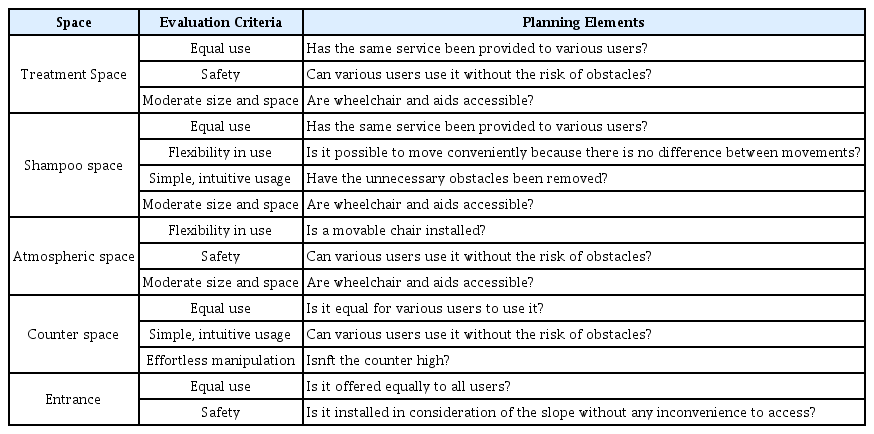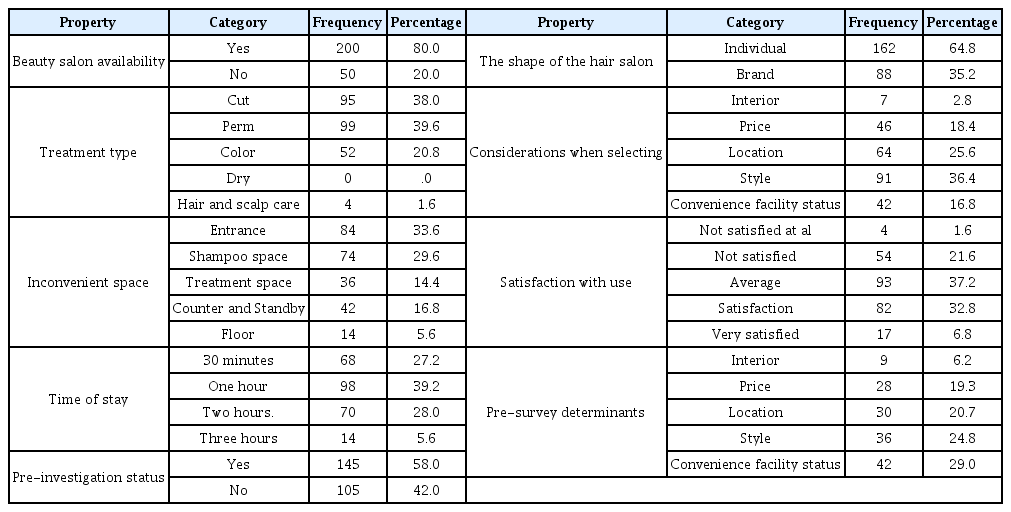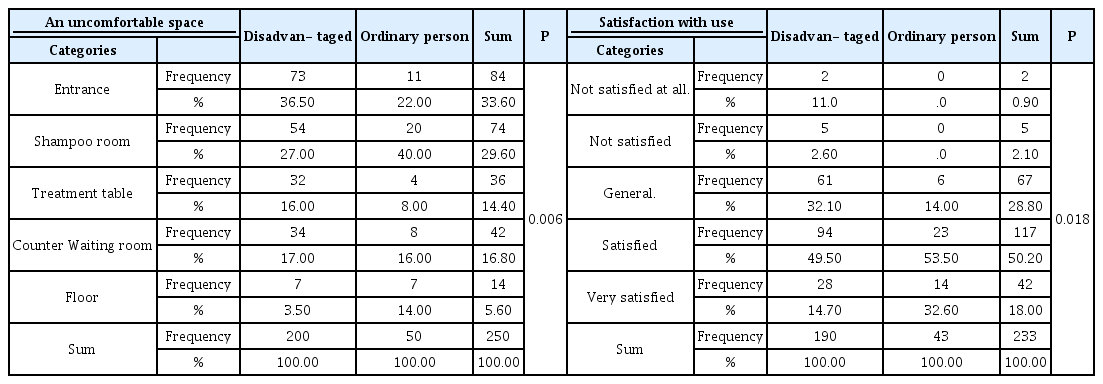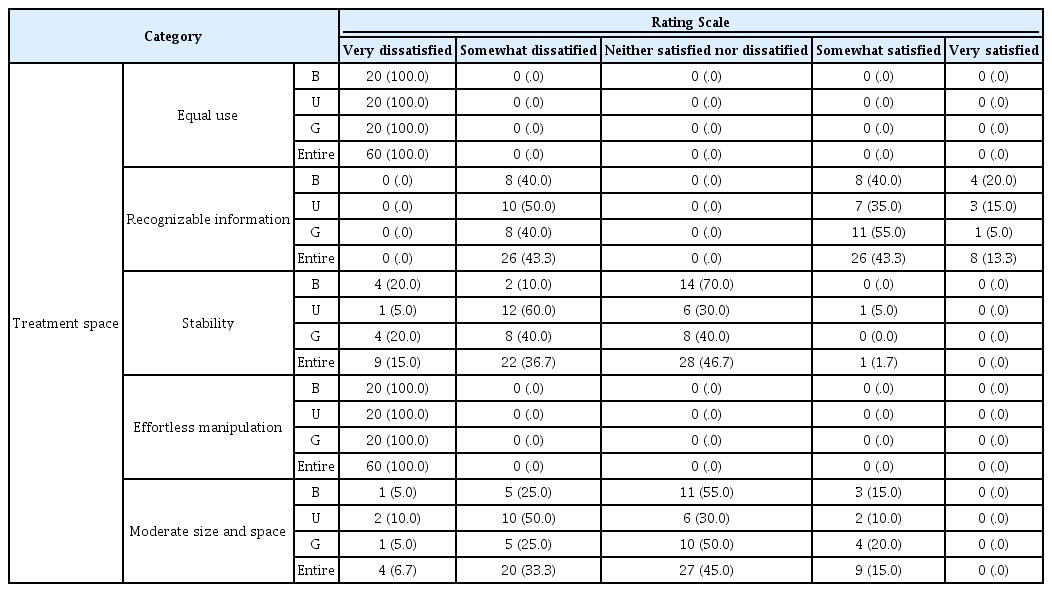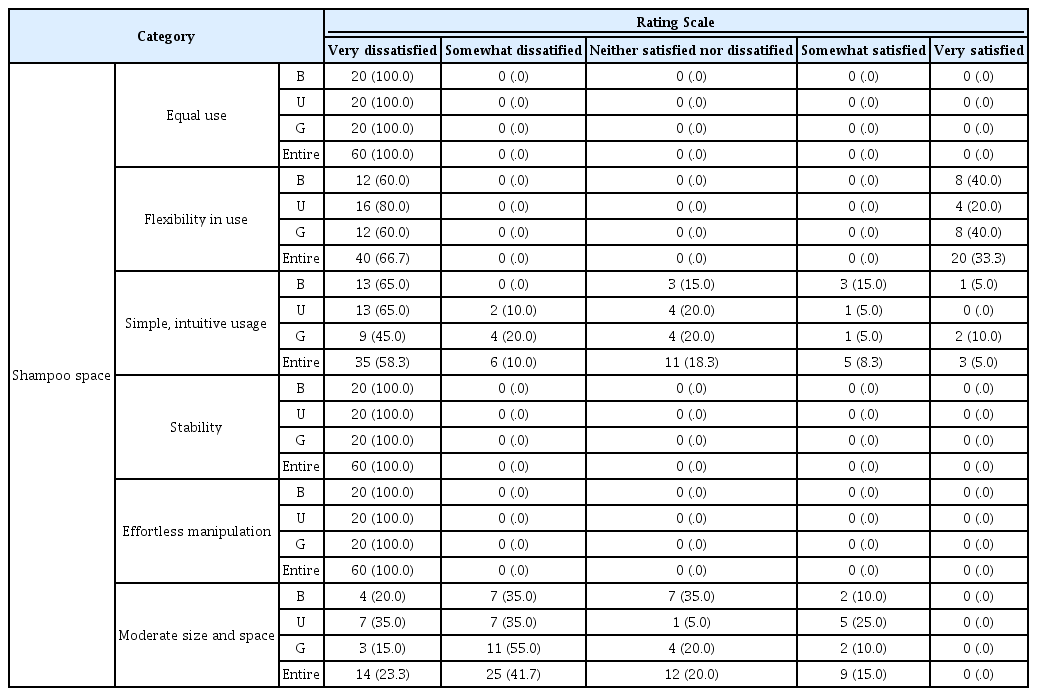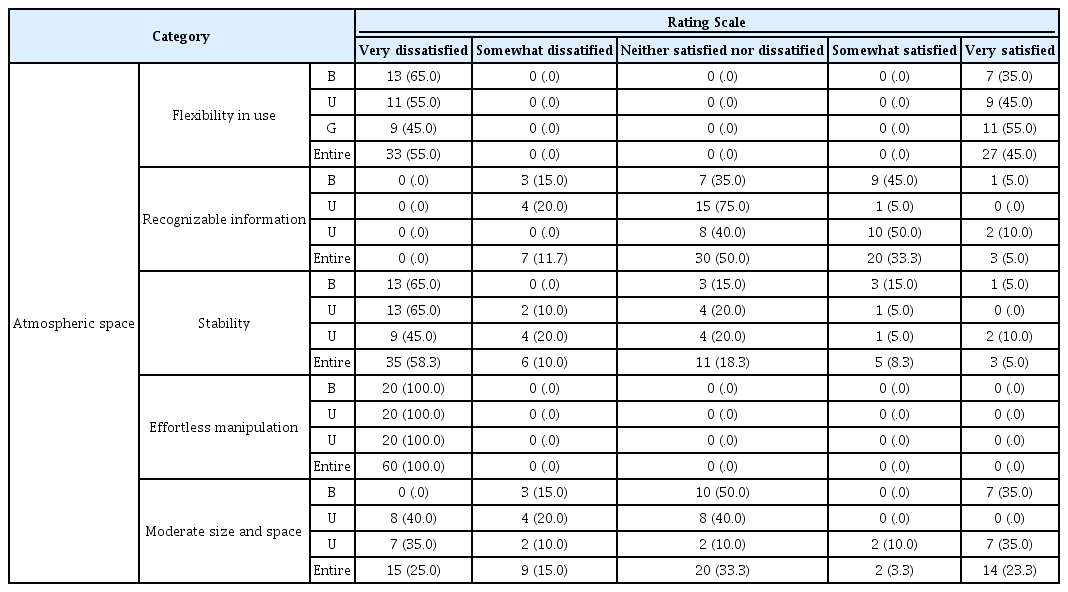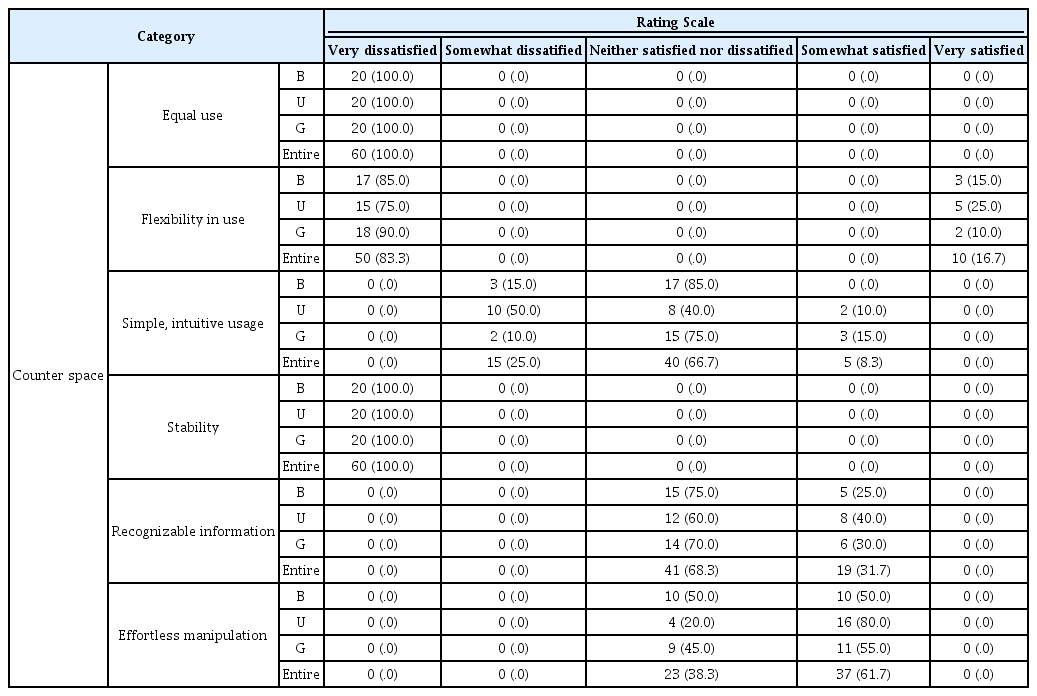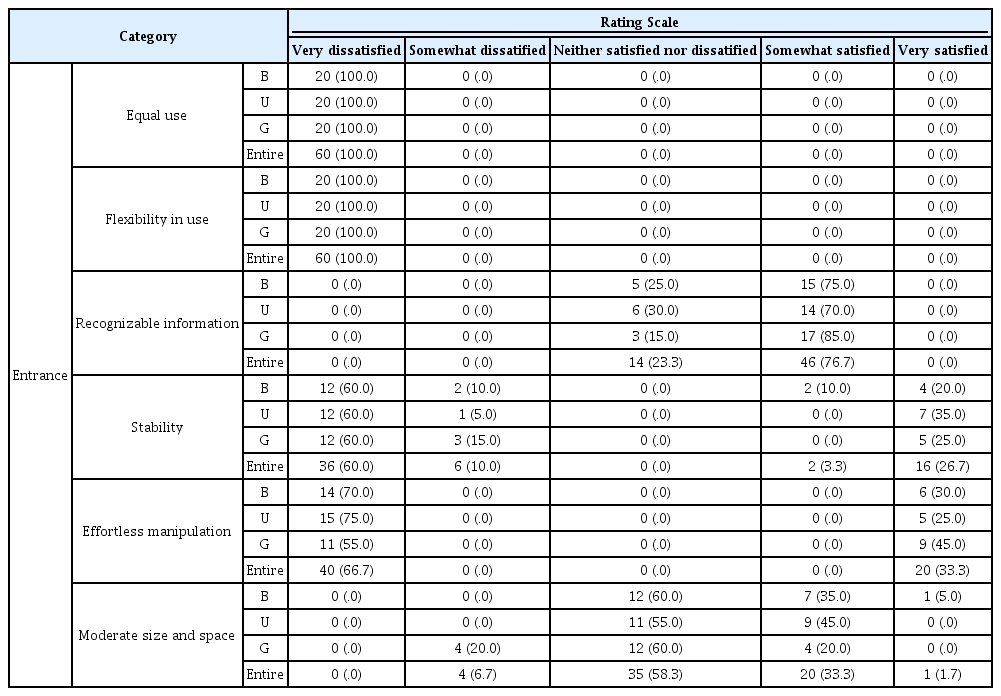사회적 약자의 미용시설 접근성 개선을 위한 실태조사 및 공간 평가지표 연구
A Study on the Actual Conditions and Space Evaluation Indicators for Improving Access to Beauty Facilities for the Social Weak
Article information
Trans Abstract
First, this study examined the theoretical background through analysis of previous studies related to the socially disadvantaged, access to hair salons, and space. Second, in order to find out the need for beauty salon evaluation indicators, a survey was conducted on hair salon recognition and necessity, and frequency analysis was performed using SPSS 26.0. Third, in order to increase the reliability of the salon space evaluation index, verification and supplementation were conducted through expert advice, and finally, the salon space evaluation index was derived. Fourth, based on the derived evaluation indicators, the evaluation was conducted by visiting the hair salon on-site, and the following research results were obtained after frequency analysis through SPSS 26.0. As a result of the survey on the recognition and necessity of the salon, the uncomfortable space of the salon could be identified through the entrance. In the reliability verification of the expert group, it was proposed to install a guide sign, install a safety handle, and install a braille block. Based on the evaluation index of hair salon space, the frequency analysis showed that all hair salons were “very not” in equal use and easy operation of facility space, and all hair salons were “very not” in equal use, safety, and easy operation of shampoo space. In addition, all hair salons were found to be “very different” in terms of easy operation of waiting spaces, equal use of counter spaces, equal use of entrances, and flexibility in use.
I. 서 론
2020년 기준 사회적 약자는 전국 총 16,763천 명으로 인구 대비 32%의 비율로 국민의 3명 중 1명으로 볼 수 있으며, 유형별로 사회적 약자 대비 고령자가 50.7%, 어린이 19.3%, 장애인 15.7%, 영유아동반자 12 .7%, 임산부 1.6% 순으로 나타났다(Min, 2021). 이에 사회적 약자에 대한 배려가 더는 비장애인의 배려가 아닌 전 국민이 함께 고민하며 풀어가야 할 사회적 책무이며, 이러한 현실을 인식하고 함께 맞춰 나아가야하는 변화가 필요한 시점이다(Cho, 2015). 그리하여 현재 사회는 장애인, 고령자, 임산부, 어린이 등 모든 사회 구성원에게 균형적인 복지를 충족시키고자 노력하고 있으며 이러한 점을 개선하고자 사회적 약자를 위한 유니버설 디자인 적용사례가 늘어나고 있다(Shin, 2020). 유니버설 디자인은 UD라고 표기하며 환경, 건축, 제품 등을 넘어 교육, 패션, 서비스 등도 포함하여 광의의 ‘최대한 많은 사람이 편리하게 생활하는 사회를 구현하는 디자인’으로 그 범위가 점차 늘어나면서(Lee, 2007), 다중이용시설에 UD의 개념이 적용되어야 한다는 필요성을 인식하고 주거 단지 커뮤니티 시설, 종합병원 공용 공간, 업무시설, 상업 공간 등을 대상으로 한 사회적 약자를 위한 연구가 진행되고 있다(Yoo, 2015). 하지만 아직까지 미용실에 사회적 약자를 위한 UD을 적용한 사례는 찾아보기 힘든 실정이며(Oh, 2011), 이에 본 연구는 복지와 UD 적용 의무가 확산됨에 따라 미용실 환경이 개선되어야 된다고 판단되어 이러한 문제점을 개선하고자 사회적 약자의 미용실 접근성 개선을 위한 공간 평가지표를 제안하며, 미용실의 공간을 평가하여 현황을 알아보고자 한다.
II. 이론적 배경
1. 사회적 약자
1) 사회적 약자 분류 및 특성
사회적 약자는 장애인, 고령자, 임산부, 영유아 동반자, 어린이 등 생활을 영위함에 있어 이동에 불편함을 느끼는 자로서 [교통약자의 이동편의 증진법] 제2조의 대상을 의미한다. 신체적 능력의 최고조는 유년기에서 성인기이며 사람마다 개인차가 있지만 나이가 들면서 점점 하락하여 장애를 극복하는 활동의 한계점 이하로 내려가면서 신체적 약자가 되며 사회적 약자의 대표적인 특성은 신체적으로 제약이 있다는 점이다. 신체 능력 기준에 따라 장애인이 가장 낮으며 고령자, 어린이, 영유아 동반자, 일반인 순으로 신체 능력이 차이가 난다(Kim, 2017).
2. 미용실 현황 및 공간 구성
2021년 통계청의 통계조사에 따르면 전국에 약 11만개의 미용실이 영업 중이며 2 02 0년 기준 10년 동안 2 8% 증가하였다. 경기(2만4453곳)와 서울(1만8912곳)이 가장 많으며, 미용실 창업률은 8.2 %이며 폐업률은 6.2 %로 나타났다. 미용실 공간은 안내 공간, 고객용 탈의실 및 락카, 대기 공간, 약제실, 샴푸 공간, 셋팅 공간, 헤어제품 디스플레이 공간, 화장실, 직원실 등으로 구성된다. 점포 크기에 따라 여러 가지 기능을 조합하여 간단히 구성하거나 더욱 세분화하여 구성하기도 한다. 대표적으로 스타일링 공간, 샴푸 공간, 리셉션 공간, 대기 공간으로 총 다섯 공간으로 나누어진다(Yoo, 2010). 스타일링 공간은 가장 큰 비중을 차지하며 미용실 및 보조 미용사가 다양한 미용 서비스를 제공하는 공간이다. 펌, 염색, 커트, 드라이 등 대부분의 작업이 이루어지며 미용사와 고객의 마찰이 가장 많은 곳이므로 동선상의 철저한 배려가 필요하다(Shin, 1998). 샴푸 공간은 미용행위가 시작되는 공간이기도 하며 샴푸행위가 시작되는 공간이며 고객의 이동이 잦은 공간이므로 동선 흐름에 유의하여야 한다. 리셉션 공간은 출입구, 헤어관련 디스플레이 공간, 카운터, 고객락카 등으로 구성되며 고객이 진출입시 처음 접하게 되는 공간으로 부드러운 연출이 필요하다(Jang, 2005). 대기 공간은 고객이 서비스를 받기 전 잠시 대기하는 공간이기도 하지만 경우에 따라서 와인딩, 중화 등 보조 작업 공간의 역할이므로 많이 배려가 필요한 공간이다(Yoo, 1996).
3. 공간 평가지표
1) 유니버설 디자인 5원칙
국내에서는 기존의 UD4원칙, 7원칙 원리와 머사 앤 리의 사용자 이득 기준을 종합, 수정하여 UD5원칙을 제시하였다(Lee, 2007). UD5원칙은 첫 번째, 기능적 지원성은 공간의 기능성, 공간의 신체적 기능을 의미하며 공간계획상 효율성, 사용상의 편의성, 다기능성, 고기능성을 포함한다. 두 번째, 수용성은 다양한 사용자에 대한 배려, 사용 가능성을 의미하며 환경적응 변화에 대비한 공간의 조절, 변경가능성, 사용상의 융통성, 여러방법 제공을 포함한다. 세 번째, 커뮤니케이션 효율성은 공간의 정보를 효과적으로 전달, 이해를 의미하며 복잡성의 제거, 단순, 직관 등을 포함한다. 네 번째, 쾌적성은 안전사고로부터 예방을 의미하며 위험, 상해 오류와 장애, 안전, 내구성 등을 포함한다. 다섯 번째, 접근성은 공간이 지니는 물리적 장애, 심리적 장애를 의미하며 장애물 제거, 휠체어접근, 시각적 접근성을 의미한다.
4. 선행연구
미용실 실내디자인의 선행연구를 살펴보면, Jang(2005)은 미용실 실내디자인 분야에서 그린 디자인의 적용가능성과 방법을 제시하였다. UD관점 평가연구의 선행연구를 살펴보면, Min(2009)은 공공디자인 관련 사업의 문제점 파악 후 행정제도와 행정시스템을 모색하였으며, 장애인 이동권의 선행연구를 살펴보면 Lee(2018)은 장애인 이동권 관련 규범에 대한 연구를 통해 실질적 장애인 이동권의 보장 방안을 모색하였다. 사회적 약자의 안전 선행연구를 살펴보면, Kim(2019)은 사회복지시설의 산업재해 승인자를 대상으로 재해특성을 체계적으로 분석하였다. 하지만 본 연구의 목적인 사회적 약자의 미용시설 접근성 개선을 위한 연구는 전무한 실정이다.
III. 내용 및 방법
1. 연구 도구 및 방법
본 연구는 미용실에 적용 가능한 미용실 공간 평가지표를 구상하기 위해 먼저 미용실 이용, 만족도 사전 조사를 실시하였다. 또 예비 미용실 공간 평가지표를 도출하여 전문가집단에게 타당성 및 신뢰도 검증을 실시하여 수정 및 보완 후 최종 미용실 공간 평가지표를 도출하였다. 그 기준으로 미용실 공간 현황 조사를 실시하였다.
1) 사전조사
2022년 9월 2일~9월 28일까지 장애인 50명, 임산부 50명, 고령자 50명, 영유아 동반자 50명, 일반인 50명 총 250명에게 구글 폼 및 현장 설문조사를 실시하였으며 설문조사 구성 및 항목으로는 인구 통계학적 특성 6문항 Kim(2017), 미용실 이용, 만족도 조사 9문항 Woo(2013)으로 총 15문항으로 SPSS 26.0 통계프로그램을 이용하여 빈도분석을 실시하였다.
2) 미용실 공간 예비 평가지표
UD5원칙, 관련법규를 바탕으로 미용실에 맞게 구성하였으며 자세한 내용은 <Table 3>과 같다.
3) 전문가 회의 및 검증
검증 평가를 위한 전문가는 미용교육 분야에서 박사학위 소지자로 10년 이상 경력을 갖춘 2인과 사회복지 분야에서 10년 이상의 경력을 갖춘 석사학위 소지자 2인, 시설 및 인테리어 관련 분야에서 10년 이상 경력을 갖춘 석사학위 소지자 2인으로 총 6인의 전문가로 구성하였다. 미용실 공간 평가지표의 타당성 검증을 위해 2 02 2년 10월 2일, 10월 19일 1차, 2차 회의를 진행하였다.
2. 평가 도구 및 방법
미용실의 사회적 약자를 위한 공간 여부를 알아보고자 미용실 공간 현황을 조사하였다. 본 연구의 대상은 부산, 울산, 경남 미용실 60곳을 대상으로 하였으며, 연구 기간은 2 02 2년 10월 20일부터 12월 20일까지 현장조사를 실시하였다. 평가 기준은 미용실 평가지표를 사용 하였으며 SPSS 26.0 통계프로그램을 이용하여 빈도분석 하였다.
IV. 결과 및 고찰
1. 미용실 유니버설 디자인 필요 유무 사전 조사 결과
1) 인구통계학적 속성 결과
본 연구에 참여한 응답자 총 2 50명의 인구통계학적 속성인 사회적 약자 유무, 사회적 약자 분류, 연령, 성별, 결혼 여부, 최종 학력의 6개 항목에 대한 분석 결과는 <Table 4>와 같다.
분석 결과, 사회적 약자 유무의 경우, ‘사회적 약자’가 200명(80%)으로 ‘일반인’ 50명(20%)에 비하여 높은 응답 비율을 보이고 있다. 사회적 약자 분류의 경우, ‘장애인’, ‘임산부’, ‘고령자’, ‘영유아 동반자’가 모두 50명(25%)으로 동일한 응답 비율을 보이고 있다. 연령은 ‘30~40대’가 12 5명(50%)으로 가장 응답 비율이 높았으며, 성별은 ‘여성’이 159명(63.6%)으로 ‘남성’ 91명(36.4%)에 비하여 높은 응답 비율을 보이고 있는 것으로 나타났다. 결혼 여부는 ‘기혼’이 155명(62.0%)으로 가장 응답 비율이 높았으며, 최종 학력은 ‘대학교’가 83명(33.2%)으로 가장 응답 비율이 높게 나타났다.
2) 미용실 이용, 만족도 조사 결과
미용실 이용 여부의 응답 결과, ‘네’가 250명(100.0%)으로 나타났으며, 이용 미용실 형태의 응답 결과, ‘개인미용실’이 162명(64.8%)으로 ‘브랜드 미용실’ 88명(35.2%)에 비하여 높은 응답을 나타냈다. 시술 종류의 응답 결과, ‘펌’이 99명(39.6%)으로 가장 응답 비율이 높았으며, 선택 시 고려사항의 응답 결과, ‘스타일’이 91명(36,4%)으로 가장 응답 비율이 높게 나타났다. 불편한 공간의 응답 결과, ‘입구’가 84명(33.6%)으로 가장 응답 비율이 높았으며, 이용 만족도의 응답 결과, ‘보통’이 93명 37.2%)으로 가장 응답 비율이 높게 나타났다. 체류시간의 응답 결과 ‘1시간 이상’이 98명(39.2%)으로 가장 응답 비율이 높았으며, 사전조사 유무의 응답 결과, ‘네’가 145명(58.0%)으로 ‘아니오’ 105명(42.0%)에 비하여 높은 응답 비율을 보이고 있는 것으로 나타났으며 사전조사 결정요인의 응답 결과, ‘편의시설 여부’가 42명(29.0%)으로 가장 응답 비율이 높게 나타났다.
3) 사회적 약자에 따른 차이 분석
사회적 약자에 따른 불편했던 공간의 차이 분석 결과, 유의확률값이 0.006으로 신뢰수준 95%하에서 차이를 보이고 있으며, 사회적 약자는 ‘입구’의 응답이 상대적으로 높은 반면, 일반인은 ‘샴푸 공간’의 응답이 상대적으로 높은 것으로 나타났다. 사회적 약자에 따른 시설 이용 만족도의 차이 분석 결과, 유의확률값이 0.018로 신뢰수준 95%하에서 차이를 보이고 있으며, 사회적 약자는 ‘보통임’의 응답 비율이 상대적으로 높은 반면, 일반인은 매우 ‘만족함’의 응답 비율이 상대적으로 높은 것으로 나타났다. 상세한 내용은 <Table 6>과 같다.
2. 전문가 검증 결과
본 연구는 미용실 예비 체크리스트를 도출하였으며 관련 전문가집단과 1, 2차 회의를 진행하였다. 회의 결과 미용 전문가는 공간별 안내표지판을 제안하였으며, 사회복지 전문가는 안전손잡이 설치를 제안하였다. 또 시설 및 인테리어 전문가는 입구를 알리는 점자블록의 설치를 제안하였다.
3. 미용실 공간 최종 평가지표
UD5원칙과 관련법규를 바탕으로 구성된 미용실 UD 체크리스트는 <Table 7>과 같다.
4. 미용실 공간 평가지표 결과
1) 시술 공간
시술 공간의 평등한 사용 평가 결과는 ‘매우 그렇지 않다’ 가 60곳(100.0%)으로 나타났으며, 인지할 수 있는 정보 평가 결과는 ‘그렇지 않다’, ‘그렇다’ 각각 26곳(43.3%)으로 나타났다. 안정성 평가 결과는 ‘보통이다’ 가 28곳(46.7%)으로 나타났으며, 힘들지 않는 조작의 평가 결과는 ‘매우 그렇지 않다’ 60곳 (100.0%)으로 나타났다. 또 적당한 크기와 공간의 평가 결과는 ‘보통이다’ 가 27곳(45%)으로 나타났다. 자세한 내용은 <Table 8>과 같다.
2) 샴푸 공간
샴푸 공간의 평등한 사용의 평가 결과는 ‘매우 그렇지 않다’가 60곳(100.0%)으로 나타났으며, 사용상의 융통성의 평가 결과는 ‘매우 그렇지 않다’ 가 40곳(66.7%)으로 가장 높게 나타났다. 간단, 직관적 사용법의 평가 결과는 ‘매우 그렇지 않다’ 가 35곳(58.3%)으로 가장 높게 나타났으며, 안전성의 평가 결과는 ‘매우 그렇지 않다’ 가 60곳(100.0%)으로 나타났다. 힘들지 않는 조작의 평가 결과는 ‘매우 그렇지 않다’ 가 60곳(100.0%)으로 나타났으며, 적당한 크기와 공간의 평가 결과는 ‘그렇지 않다’ 가 25곳(41.7%)으로 가장 높게 나타났다. 자세한 내용은 <Table 9>와 같다.
3) 대기 공간
대기 공간의 사용상의 융통성의 평가 결과는 ‘매우 그렇지 않다’ 가 33곳(55.0%)으로 가장 높게 나타났으며, 인지할 수 있는 정보의 평가 결과는 ‘보통이다’ 가 30곳(50.0%)으로 가장 높게 나타났다. 안전성의 평가 결과는 ‘매우 그렇지 않다’ 가 35곳(58.3%)으로 가장 높게 나타났다. 힘들지 않는 조작의 평가 결과는 ‘매우 그렇지 않다’ 가 60곳(100.0%)으로 나타났으며, 적당한 크기와 공간의 평가 결과는 ‘보통이다’ 가 20곳(33.3%)으로 가장 높게 나타났다. <Table 10>과 같다.
4) 카운터 공간
카운터 공간의 평등한 사용의 평가 결과는 ‘매우 그렇지 않다’ 가 6곳(100.0%)으로 나타났으며, 사용상의 융통성의 평가 결과는 ‘매우 그렇지 않다’ 가 50곳(83.3%)으로 가장 높게 나타났다. 간단, 직관적 사용법의 평가 결과는 ‘보통이다’ 가 40곳 (66.7%)로 가장 높게 나타났으며, 안전성의 평가 결과는 ‘매우 그렇지 않다’ 가 60곳(100.0%)으로 나타났다. 인지할 수 있는 정보 의 평가 결과는 ‘보통이다’ 가 41곳(68.3%)으로 가장 높게 나타났으며, 힘들지 않는 조작의 평가 결과는 ‘그렇다’ 가 37곳(61.7%)으로 나타났다. 자세한 내용은 <Table 11>과 같다.
5) 입구
입구의 평등한 사용의 평가 결과는 ‘매우 그렇지 않다’ 가 6곳(100.0%)으로 나타났으며, 사용상의 융통성의 평가 결과는 ‘매우 그렇지 않다’ 가 60곳(100.0%)으로 나타났다. 인지할 수 있는 정보의 평가 결과는 ‘그렇다’ 가 46곳(76.7%)으로 가장 높게 나타났으며, 안전성의 평가 결과는 ‘매우 그렇지 않다’ 가 36곳(60.0%)으로 가장 높게 나타났다. 힘들지 않는 조작의 평가 결과는 ‘매우 그렇지 않다’ 가 40곳(66.7%)으로 가장 높게 나타났으며, 적당한 크기와 공간의 평가 결과는 ‘보통이다’ 가 35곳(58.3%)으로 나타났다. 자세한 내용은 <Table 12>와 같다. 조사 결과 아직까지 미용실에 사회적 약자를 위한 공간이 부족한 것으로 나타났으며 Kim(2019)의 연구를 살펴본 결과도 사회적 약자를 위한 공간은 협소한 것으로 나타났다.
V. 결 론
시대적 변화에 따른 사회적 약자의 증가와 사회적 약자의 접근성에서 본 연구는 시작되었다. 미용실의 수요와 공급이 활발하게 증가하고 있음에도 특정 계층만을 위한 공간이 아니라 다양한 계층에 사용상 평등한 기회가 제공되지 않고 있기에 사회적 약자를 위한 공간이 미용실에 적용되어야 함을 착안하고 설문조사, 현장 평가조사, 빈도분석을 실시하여 연구를 진행하였다. 첫째, 사회적 약자의 접근성을 위한 미용실 공간 수준 정도를 파악할 필요성 있다고 판단하였으며 UD5원칙과 관련 법규로 구성 된 미용실 공간 평가지표를 구성하기 위해 미용실 인식 및 필요성여부 조사를 실시하였으며, 그 결과 미용실의 불 편했던 공간은 입구로 가장 높은 응답 결과를 나타냈다. 이에 미용실에 사회적 약자를 위한 접근성 개선 및 공간이 필요한 것으로 판단되었다. 둘째, 미용실 공간 평가지표의 정확성 및 신뢰성을 높이기 위해 전문가 자문을 통해 검증 및 보완을 실시해 최종적으로 미용실 공간 평가지표를 도출하였다. 도출된 미용실 공간 평가지표 기준으로 미용실에 현장 방문하여 평가를 실시하였으며 SPSS를 통해 빈도 분석 결과 시설 공간의 평등한 사용과 힘들지 않는 조작에서 모든 미용실이 ‘매우 그렇지 않다’ 로 나타났으며 샴푸 공간의 평등한 사용과, 안전성, 힘들지 않는 조작에서도 모든 미용실이 ‘매우 그렇지 않다’ 로 나타났다. 또 대기 공간의 힘들지 않는 조작, 카운터 공간의 평등한 사용, 안전성, 입구의 평등한 사용, 사용상의 융통성에서도 모든 미용실이 ‘매우 그렇지 않다’ 로 나타났으며 현재 운영 중인 미용실에 사회적 약자를 위한 공간이 전체적으로 매우 낮음을 파악할 수 있었다. 이러한 결과를 토대로 미용실 사회적 약자를 위한 개선이 빠르게 이루어져야 된다고 판단된다. 본 연구의 미용실 공간 평가 현황조사에서 연구 대상 범위를 좀 더 넓히지 못한 점이 이 연구의 한계로 남으며 추후 조사범위를 넓혀 평가를 진행 한다면 좀 더 정확한 수치를 확인할 수 있을 것으로 판단된다. 또 미용실 공간에 대한 좀 더 세부적인 가이드라인에 대한 연구가 진행된다면 미용실 종사자와 고객 모두의 안전성과 편리성이 제공될 것으로 판단된다.


